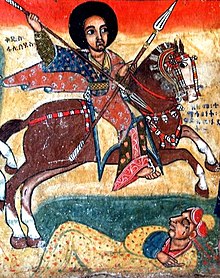| Fasilides ዓፄ ፋሲለደስ | |||||||||
|---|---|---|---|---|---|---|---|---|---|
| Negusa Nagast | |||||||||
 Mural depicting Emperor Fasilides at Ura Kidane Mehret Church, Ethiopia | |||||||||
| Emperor of Ethiopia | |||||||||
| Reign | 1632 – 18 October 1667 | ||||||||
| Predecessor | Susenyos I | ||||||||
| Successor | Yohannes I | ||||||||
| Born | 20 November 1603 Bulga, Shewa, Ethiopian Empire | ||||||||
| Died | 18 October 1667 (aged 63) Azezo, Ethiopian Empire | ||||||||
| Issue | Four sons and one daughter, including Yohannes I and David[1] | ||||||||
| |||||||||
| Dynasty | House of Solomon | ||||||||
| Father | Susenyos I | ||||||||
| Mother | Sahle Work | ||||||||
| Religion | Ethiopian Orthodox Tewahedo | ||||||||
Fasilides (Ge'ez: ፋሲለደስ; Fāsīladas; 20 November 1603 – 18 October 1667), also known as Fasil,[2] Basilide,[3] or Basilides (as in the works of Edward Gibbon), was Emperor of Ethiopia from 1632 to his death on 18 October 1667, and a member of the Solomonic dynasty. His throne name was Alam Sagad (Ge'ez: ዓለም ሰገድ).
Renowned as the founder of Gondar, the capital of the Ethiopian Empire, Fasilides ushered in the Gondarine period. Notably, he confiscated and exiled the Jesuits, while also establishing security alliances with neighboring Islamic sultanates. Additionally, he played a crucial role in leading the campaign against the Agaw rebels. In 1666, following his son Dawit's rebellion, Fasilides had him imprisoned in Wehni. The emperor himself died a year later and was laid to rest in a monastery on Daga Island in Lake Tana.
- ^ Budge, E. A. Wallis (1928). A History of Ethiopia: Nubia and Abyssinia (Volume 2). London: Methuen & Co. p. 397.
- ^ Woredekal, Solomon (1985). "Restoration of historical monuments of Gondar". Annales d'Éthiopie. 13: 119. doi:10.3406/ethio.1985.926. Retrieved 12 July 2014.
- ^ Wion, Anaïs (2012). "Fasiladas". Dictionary of African Biography. Vol. 2. OUP. pp. 353–54. ISBN 9780195382075.